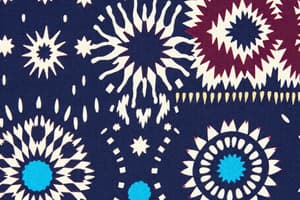Podcast
Questions and Answers
What is the primary characteristic that distinguishes ikat from other resist-dyeing techniques like tie-dye and batik?
What is the primary characteristic that distinguishes ikat from other resist-dyeing techniques like tie-dye and batik?
- Ikat applies the resist to the finished cloth, while tie-dye and batik apply it to the yarns.
- Ikat always involves multiple colors, whereas tie-dye and batik are monochromatic.
- Ikat uses synthetic dyes, while tie-dye and batik use natural dyes.
- Ikat applies the resist to the yarns before dyeing and weaving, while tie-dye and batik apply it to the finished cloth. (correct)
In ikat, if the dyed yarns are perfectly aligned during weaving, the resulting design will be sharply focused with no blurriness.
In ikat, if the dyed yarns are perfectly aligned during weaving, the resulting design will be sharply focused with no blurriness.
False (B)
What causes the blurred design, a characteristic feature of ikat textiles?
What causes the blurred design, a characteristic feature of ikat textiles?
Difficulty in precisely aligning the dyed yarns
In ikat, the resist is formed by binding individual yarns or bundles of yarns with a tight ______ applied in the desired pattern.
In ikat, the resist is formed by binding individual yarns or bundles of yarns with a tight ______ applied in the desired pattern.
Match the type of ikat with its description:
Match the type of ikat with its description:
Which type of ikat is generally considered the most difficult to produce?
Which type of ikat is generally considered the most difficult to produce?
Weft ikat is easier to produce than warp ikat because weft yarns do not require precise placement during weaving.
Weft ikat is easier to produce than warp ikat because weft yarns do not require precise placement during weaving.
In warp ikat production, how can weavers adjust the yarn placement to refine the design as the cloth is woven?
In warp ikat production, how can weavers adjust the yarn placement to refine the design as the cloth is woven?
The double ikat produced in Patan, Gujarat in India, known as ______, is made using fine silk yarns and natural dyes.
The double ikat produced in Patan, Gujarat in India, known as ______, is made using fine silk yarns and natural dyes.
Match the region with its notable ikat textile:
Match the region with its notable ikat textile:
Which material is traditionally used to make patola saris in Gujarat, India?
Which material is traditionally used to make patola saris in Gujarat, India?
Kasuri, the Japanese form of ikat, is exclusively produced as double ikat.
Kasuri, the Japanese form of ikat, is exclusively produced as double ikat.
What plant fiber is used to create bashofu cloth, often dyed using ikat techniques, in Okinawa, Japan?
What plant fiber is used to create bashofu cloth, often dyed using ikat techniques, in Okinawa, Japan?
In Argentina, gauchos use ikat to make the ______ (trousers).
In Argentina, gauchos use ikat to make the ______ (trousers).
Match the Ikat type with its characteristics:
Match the Ikat type with its characteristics:
Which factor does NOT influence the complexity and cost of creating ikat textiles?
Which factor does NOT influence the complexity and cost of creating ikat textiles?
Ikat production is limited to Southeast Asia, with no evidence of its independent development in other regions.
Ikat production is limited to Southeast Asia, with no evidence of its independent development in other regions.
Besides clothing, what are some other items for which ikat fabrics are used in Uzbekistan and Yemen?
Besides clothing, what are some other items for which ikat fabrics are used in Uzbekistan and Yemen?
Unlike tie-dye and batik, ikat creates the surface design in the ______ rather than on the finished cloth, resulting in patterned faces on both sides of the fabric.
Unlike tie-dye and batik, ikat creates the surface design in the ______ rather than on the finished cloth, resulting in patterned faces on both sides of the fabric.
Match the regional variations to their known fabrics:
Match the regional variations to their known fabrics:
Flashcards
Ikat
Ikat
A dyeing technique where yarns are resist-dyed before weaving, creating patterns in the fabric.
Ikat's blurred design
Ikat's blurred design
The blurriness is caused by the difficulty in perfectly aligning dyed yarns during weaving.
Warp-faced Ikat
Warp-faced Ikat
Warp-faced ikat involves dyeing only the warp yarns using the ikat technique.
Weft-faced Ikat
Weft-faced Ikat
Signup and view all the flashcards
Double Ikat
Double Ikat
Signup and view all the flashcards
Patola
Patola
Signup and view all the flashcards
Kasuri
Kasuri
Signup and view all the flashcards
Bashofu
Bashofu
Signup and view all the flashcards
Study Notes
- Ikat is a dyeing technique used to pattern textiles that employs resist dyeing on the yarns prior to dyeing and weaving the fabric.
- In ikat, the resist is formed by binding individual yarns or bundles of yarns with a tight wrapping applied in the desired pattern.
- The yarns are then dyed.
- The bindings may then be altered to create a new pattern and the yarns dyed again with another colour.
- This process may be repeated multiple times to produce complex, multicoloured patterns.
- When the dyeing is finished all the bindings are removed and the yarns are woven into cloth.
- In other resist-dyeing techniques such as tie-dye and batik, the resist is applied to the finished cloth rather than to the yarns.
- Because the surface design is created in the yarns rather than on the finished cloth, in ikat both fabric faces are patterned.
- A characteristic of ikat textiles is a blurred design.
- The blurriness is a result of the difficulty in precisely aligning the dyed yarns so the pattern comes out perfectly "in focus".
- The blurriness can be reduced by using finer yarns or by simplifying the design.
- Ikats with little blurriness, multiple colours and complicated patterns are more difficult to create and therefore more expensive.
- Ikat is produced in many countries around the world, from India to Central Asia, Southeast Asia, Japan (where it is called kasuri), Africa, and Latin America.
- Ikat is thought to have originated independently in several different locations.
Types of Ikat
- Warp-faced ikat: warp yarns are dyed using the ikat technique
- Weft-faced ikat: weft yarns are dyed using the ikat technique
- Double ikat: both the warp and the weft yarns are dyed using the ikat technique
Warp Ikat
- Warp ikat is probably the simplest to produce.
- The warp yarns are wound onto a frame.
- Next they are grouped and tied so the desired design emerges.
- The yarns are then dyed.
- This process can be repeated multiple times with different colours.
- When the dyeing is completed, the bindings are removed and the warp yarns are loaded onto the loom.
- By adjusting the placement of the warp yarns, the weaver can sharpen the design as the cloth is woven.
- Warp ikats are common in Southeast Asia, South America, and Europe.
Weft Ikat
- Weft ikat is more difficult to produce than warp ikat because the weft yarns must be precisely placed each time a weft shot is inserted.
- The weft ikat designs tend to have angular shapes.
- Weft ikats are common in Southeast Asia and South America.
Double Ikat
- Double ikat is the most difficult to produce.
- Double ikat involves dyeing both the warp and the weft.
- To achieve complex patterns, the process requires a high degree of skill and precision.
- The double ikat produced in Patan, Gujarat in India is the most technically complex form of ikat.
- Known as patola, it is made using very fine silk yarns and dyed using natural dyes.
- It can take up to a year to make one patola sari.
- Highly prized, patola saris are worn by women for special occasions.
- Double ikat is also woven in Japan, where it is known as kasuri.
Regional variations
- Gujarat, India: Known for patola, a double ikat traditionally made using silk
- Indonesia: Ikats are common throughout Indonesia, each region having its own distinctive patterns and colours
- Japan: Known for kasuri, which can be warp, weft, or double ikat made of cotton.
- Okinawa, Japan: Known for bashofu, a cloth made from banana plant fibres that is often dyed using ikat techniques.
- Madagascar: Silk cloths are woven using ikat
- Argentina: Gauchos use ikat to make the bombachas (trousers).
- Uzbekistan: Ikat fabrics are used for making decorative panels, traditional costumes, and other items.
- Yemen: Ikat fabrics are used for making decorative panels, traditional costumes, and other items.
Studying That Suits You
Use AI to generate personalized quizzes and flashcards to suit your learning preferences.




